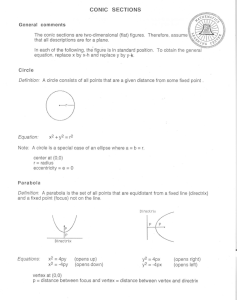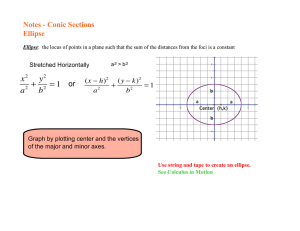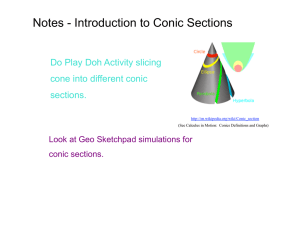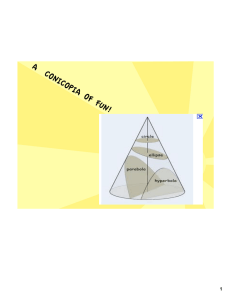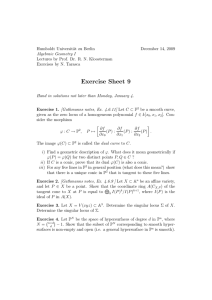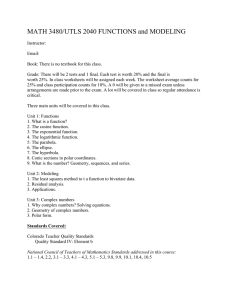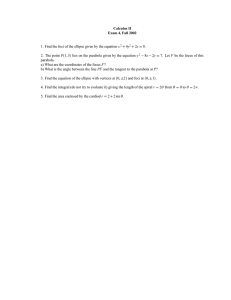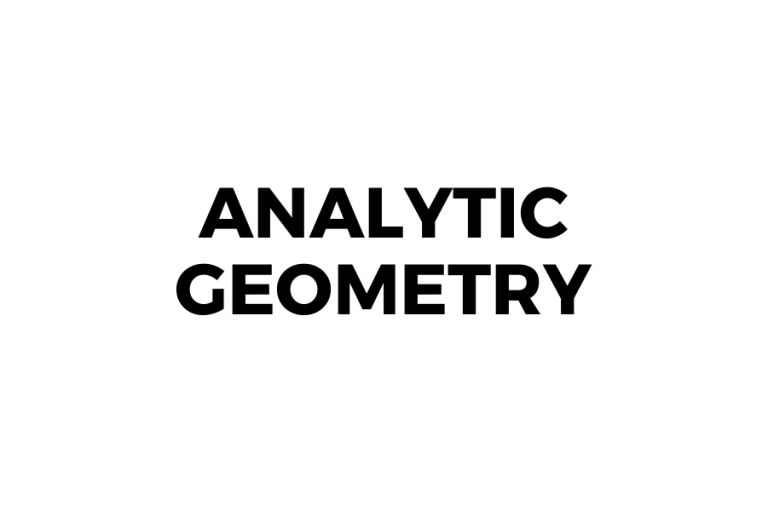
ANALYTIC GEOMETRY CONIC SECTIONS GENERAL DEFINITION OF CONIC SECTION locus (or path) of a point that moves such that the ratio of its distance from a fixed point (focus) and a fixed line (directrix) is constant. This constant ratio is called the eccentricity of the conic. Eccentricity of a conic 𝒇𝟏 𝒇𝟐 𝒇𝟑 𝒆= = = 𝒅𝟏 𝒅𝟐 𝒅𝟑 If 𝑒 = 0, it’s a circle. If 𝑒 = 1, it’s a parabola. If 𝑒 < 1, it’s an ellipse. If 𝑒 > 1, it’s a hyperbola. CIRCLE GENERAL DEFINITION A locus of a point which moves at a constant distance from a fixed point called center and the constant distance of any point from the center is called the radius. Center at 𝐶(ℎ, 𝑘) 𝒙 − 𝒉 𝟐 + 𝒚 − 𝒌 𝟐 = 𝒓𝟐 Center at origin 𝒙 𝟐 + 𝒚𝟐 = 𝒓 𝟐 General form 𝒙𝟐 + 𝒚𝟐 + 𝑫𝒙 + 𝑬𝒚 + 𝑭 = 𝟎 Center: ( h , k ) h = - D/2 k = - E/2 PARABOLA GENERAL DEFINITION A locus of a point that moves such that its distance from a fixed point called the focus is always equal to its distance from a fixed line called the directrix Standard Equation ( x – h )2 = 4a ( y – k ) ( x – h )2 = -4a ( y – k ) ( y – k )2 = 4a ( x – h ) ( y – k )2 = -4a ( x – h ) Upward Downward to the right to the left Note: (ℎ, 𝑘) is the vertex of the parabola. ELLIPSE GENERAL DEFINITION A locus of a point that moves such that the sum of its distances from two fixed points called the foci is constant. Standard Equation Properties of Ellipse HYPERBOLA GENERAL DEFINITION A locus of a point that moves such that the difference of its distance between two fixed points called the foci is constant. POINTS AND LINES ANGLES BETWEEN TWO LINES _ 𝜽 = 𝒕𝒂𝒏 𝟏 𝒎 𝟐 − 𝒎𝟏 𝟏 + 𝒎 𝟏𝒎 𝟐 Or _ _ 𝜽 = 𝒕𝒂𝒏 𝟏 𝒎𝟐 − 𝒕𝒂𝒏 𝟏 𝒎𝟏 Note: 1. Two lines are parallel if their slopes are equal. 2. Two lines are perpendicular if the product of their slopes is -1. LINE AND POINT DISTANCE Distance from (𝑥1, 𝑦1) to 𝐴𝑥 + 𝐵𝑦 + 𝐶 = 0 𝑑= 𝐴𝑥1 + 𝐵𝑦1 + 𝐶 𝐴2 + 𝐵2 Distance from (𝑥1, 𝑦1) to 𝐴𝑥 + 𝐵𝑦 + 𝐶 = 0 𝑑= 𝐶2 − 𝐶1 𝐴2 + 𝐵2 POLAR COORDINATE SYSTEM In this system, the location of a point is expressed by its distance 𝑟 from a fixed point called the pole and its angle θ from a fixed line, usually the +𝑥-axis. Relationship between Polar and Cartesian Coordinate Systems: 𝑟2 = 𝑥2 + 𝑦2 𝑜𝑟 𝑟 = 𝑥2 + 𝑦 2 𝑥 = 𝑟𝑐𝑜𝑠𝜃 , 𝑦 = 𝑟𝑠𝑖𝑛𝜃 𝑡𝑎𝑛𝜃 = 𝑦 =𝑚 𝑥

